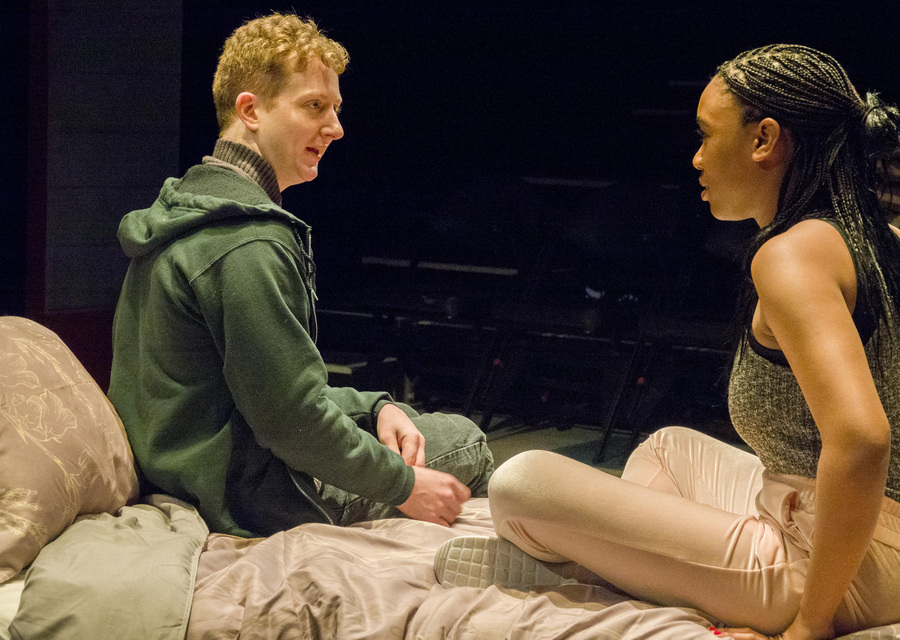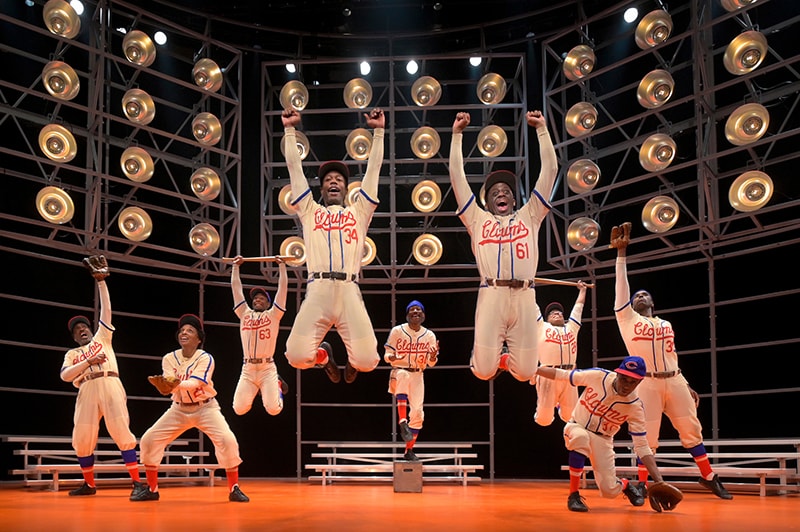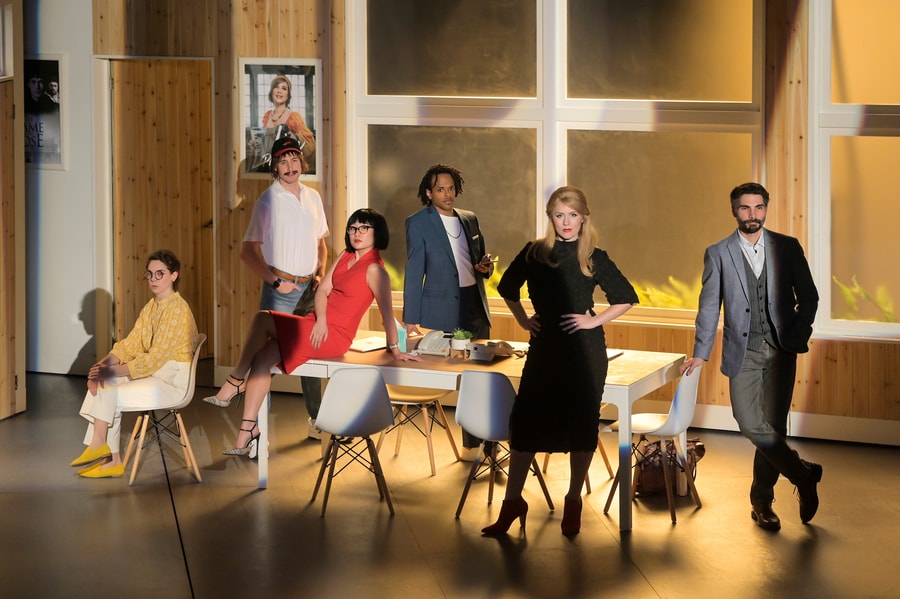“We were worried the work wouldn’t be seen,” said American Conservatory Theater executive director Jennifer Bielstein. When theatres across the country began shutting down two weeks ago to slow the spread of COVID-19, ACT was one of the first theatres (along with fellow Bay area organization Berkeley Repertory Theatre) to announce a pivot to digital. The announcement of a deal with BroadwayHD to bring ACT’s productions of Lydia R. Diamond’s Toni Stone and Branden Jacobs-Jenkins’ Gloria to ticket buyers opened more than a door—it gestured toward a potential floodgate.
The idea of streaming professional theatre isn’t exactly new. Be it BroadwayHD’s library of recorded performances, the industry pillars of National Theatre Live and the Metropolitan Opera Live bringing performances to movie theatres, or the sparsely seen, you-can-find-them-if-you-seek-them-out recorded performances of shows like Shrek: The Musical (Netflix) or the Spike Lee-produced recording of Antoinette Nwandu’s Pass Over (Amazon Prime). But this was different. This was born of a necessity and done, as Bielstein would put it, “in a really scrappy way.” Even for BroadwayHD, who has been streaming Broadway performances for more than four years, it also proved a new challenge.
“This new pilot program that we’re trying with ACT arose out of people looking at us and saying they don’t have the money to build a streaming technology platform,” said BroadwayHD co-founder Bonnie Comley, noting that the idea of extending the life of a show beyond the four walls of the theatre and the weeks of its ticketed run is already baked into their business. “BroadwayHD was for people that couldn’t get to the theatre. And now we all know what that feels like, unfortunately.”
But BroadwayHD, or any streaming service, can’t simply put Equity shows on their site and broadcast them to all comers. In return for making special provisions for video capture and sharing, the theatrical unions also have restrictions and requirements for such distribution. Indeed, in response to this crisis, Actors Equity Association created a new, temporary streaming agreement available for select producers to record these performances, sell tickets through the theatre’s website, then stream the production online for one-time viewing by ticket buyers. In essence, the idea is to make the patron experience as close to a true theatrical experience as possible. For BroadwayHD, which is generally set up more like Netflix or Hulu, with a catalog of titles available to all subscribers from their computer screen, that meant reworking their website to make sure only ticket buyers could see the performances and ensure the performances could only be viewed once.
Randy Anderson, director of contract affairs for the Stage Directors and Choreographers Society (SDC), said that some of the stipulations surrounding the broadcasting or streaming of shows affected by the pandemic shutdown included allowing theatres to broadcast only on a password-protected server (or website like BroadwayHD) for ticket purchasers for the duration of the run that was originally scheduled. There is some leeway on the timing, but as with most of the intricacies of this new step for the field, that may vary based on the theatre or the performance. There is also a concern about restricting the ability to rewatch a performance.
“One of the primary concerns for our members is that, when something goes digital and gets out there into the world, it gets really hard to take it back,” Anderson reasoned. “Our directors and choreographers own their intellectual property, so there’s a concern about replication.”
BroadwayHD’s website overhaul began mere days before the pilot program with ACT was set to begin. As Comley explained, the site’s usual widely available subscription model wouldn’t work for these new shows.
“Their shows aren’t meant for public consumption by the rest of the world,” Comley said. “It’s for a very limited audience. We worked on a really quick solution to get that one going. But it is scaling so big at this point that we have to make sure that the pilot works. We’re trying to find a solution for a problem that just sort of happened overnight, and we’re trying to build the technology around it.”
In Chicago, Theater Wit producing artistic director Jeremy Wechsler found himself personally writing and rewriting computer code to make sure the theatre’s production of Mike Lew’s Teenage Dick would be available online to ticket buyers through Vimeo (now through April 19). Wechsler had to find a way to password-protect the show and make sure it’s not readily downloadable. The result is a Vimeo stream with the bottom tracking bar removed—that means no skipping, no rewinding, no starting over once the viewing finishes. You can pause to go to the restroom or grab a snack, but because of the way Wechsler crafted this theatrical experience, it’s not encouraged.
“I really think it’s important for a theatre to preserve as much of that experience as possible,” Wechsler said. “What we’re trying to do is say, ‘Come to the theatre with us.’”
Wechsler even encourages patrons—who must buy virtual “seats” through the theatre’s website as if they’re buying tickets to a performance—to start their playthroughs as near to the “scheduled” curtain time of their given performance as possible. He even crafted a short pre-show video that leads you from the door of the building to your seat, handing you a ticket along the way. The theatre has capped the number of tickets they can sell per viewing at 98—the same number of seats that would have been available at Theater Wit had the production run as scheduled.

To be clear, while this is a great way for theatres to share work that otherwise wouldn’t be seen, and to salve the disappointment of ticket buyers who otherwise might ask for refunds, these screen-able plays will not make back all the money theatres lost due to the shutdown. In fact, the theatres I spoke with were spending anywhere from an additional $5,000 to $10,000 in equipment rental and resources to make sure these productions got seen. And AEA’s new streaming agreement, in ACT’s case, granted performers two weeks of pay for the performance they recorded.
“These new streaming agreements help protect the economic security of Equity members with additional weekly salaries and health care contributions,” said AEA executive director Mary McColl in a statement. “When theatres go dark, actors and stage managers face tremendous economic uncertainty. A streaming agreement can be a win for everyone, from the audience to the actors and stage managers.”
Ticket revenues aren’t expected to be huge: Prices for the online viewing of Toni Stone (available to view through April 5), for instance, are on a sliding scale from $15 to $100—basically “pay what you can,” and with no way except strong encouragement to charge multiple viewers for their tickets in one household.
Tickets for Teenage Dick run $28 for all performances. But for Wechsler, providing the access and exposure outweighed its costs, who found himself running out to rent cameras and microphones to capture the opening (and closing) night of Teenage Dick. The production was also working in an understudy after one performer (quite reasonably) dropped out over concerns for their health. While ACT’s Bielstein called their recordings “scrappy,” Wechsler referred to his as a “slightly butch-er archive recording.”
As SDC’s Anderson pointed out, many theatres already have allowances for archival recordings in their contracts, but these are never meant to be distributed to the public. Archival recordings, generally, are simply one camera set up in the back of the house, intended only to create a recording for posterity or performing arts libraries. In fact, according to ACT artistic director Pam MacKinnon, while Toni Stone managed a two-camera shoot (and a review not only by their hometown paper, the San Francisco Chronicle, but also a remote rave from the Wall Street Journal), their screening of Gloria (available to view through April 5) is from the production’s single-camera archival taping.
Over at BroadwayHD, Comley, co-founder Stewart Lane, and their team (which includes two staff members with COVID-19) are now fielding numerous requests from theatres who already have archival footage and are looking for space to share. Theatres, they note, must have the proper rights in place; having the rights to stage a production doesn’t equal the right to stream it. Lane also noted that viewers can’t universally expect the quality of such bespoke, captured-for-broadcast offerings, like one of Roundabout’s She Loves Me, among others, for which BroadwayHD itself did the recording, using 14 cameras.
“They’re just sort of doing it down and dirty to get them captured so that they have something to offer,” Comley said. “I think that, under these circumstances, people appreciate that.”
These captures aren’t meant to replace the act of live theatre. But they can remind you of the draw that makes live theatre special. Robert Hupp, artistic director of Syracuse Stage and director of the theatre’s production of Amadeus, said he was glad to have his production filmed in front of an audience (albeit limited in size), even as he conceded that it’s a very different experience.
“It’s not the same as being in the theatre with an audience experiencing the show,” Hupp explained. “What you miss in the video is that broad stage experience, that sort of epic scope.”
But what is gained, he said, is a more personal connection to the performers than if you were sitting in the audience 40 feet or so away from the actors. To get their Amadeus online (also reviewed remotely by the Wall Street Journal), Syracuse Stage worked quickly, over the course of around 48 hours, with local PBS affiliate WCNY to film the production. Hupp and Syracuse Stage had been approached before about the possibility of filming and broadcasting a production from the theatre, but the reality of the coronavirus forced them to revisit the conversations and “hit the accelerator.”

After contractual hurdles were cleared with the unions, WCNY was in the building the next day to film a performance that served as both the opening and closing night of Amadeus. Hupp was still reviewing edits and shot choices made by WCNY when we spoke, noting that this is a circumstance where the task of directing the eye of the audience is taken out of his hands and placed in the hands of an editor.
“What I’m enjoying about what I’m seeing is that it’s not a distortion,” Hupp said. “We make such big choices onstage, but I’m finding that, at least in our work here, with the actors in this production, it’s working on film too. It is not the same experience as live theatre, but it is a very credible artistic experience in another medium.”
The conversation around credibility is already extending to theatre critics who are ready and willing to review. Chicago Tribune theatre critic Chris Jones reviewed Theater Wit’s performance of Teenage Dick virtually (and even stuck around for the post-show talkback Theater Wit hosted via Zoom alternative GoToMeeting). San Francisco Chronicle theatre critic Lily Janiak also detailed her experience reviewing a live-streamed performance in her review of the Swiss mime troupe Mummenschanz’s you & me.
Janiak pointed out that it seems definitional for theatre to be a communal act, where everyone goes to the same place at the same time and sees the same thing. There’s something fundamentally different when you’re sitting in a room alone watching a screen as opposed to sitting in an audience of strangers, people whose mere vibes—maybe they laugh at a joke you missed?—can affect the way you experience theatre. Still, through her role as a critic, she sees a way people can find connection in a disparate time.
Said Janiak, “Maybe that’s one small way to feel a little bit less isolated right now: ‘Oh, we saw the same thing, and now I can kind of confirm what I saw or have a different perspective as a yardstick against which to measure my own.’ What a critic is prepared to offer or what we’ve been trained to offer could be extra valuable right now.”
Along with the uncertainty about when theatres can open again amid the spread of the virus, there’s the question for these new streaming and captured plays: What’s next for this form? Is there a life for these filmed and streamed productions after this is all over? Does the idea of regularly providing filmed versions of current regional and local shows for ticket buyers, or even Broadway shows, to watch at home become a trending thing, or just die off—a temporary solution to a (hopefully) temporary problem? It was Helen Shaw who, in her review of Ivo van Hove’s video-saturated Broadway production of West Side Story, astutely pointed out that “few people on earth can emote in close-up for the camera and reality’s ‘wide shot’ simultaneously; it’s an actor’s nightmare.”
But looking at the potential, as playwright Caridad Svich simply asks, “Why not?” Sure, it can take away some of the exclusivity, Svich continued, but it can also broaden the range of work that is available to people. Mickey Rowe, who played Mozart in Syracuse Stage’s production of Amadeus, sounds a similar sentiment. Rowe, co-founder of National Disability Theatre, points out that an at-home streaming option for current shows is something the disability community has been calling for for a long time.
“This should always be an option,” Rowe said. “For a lot of people with disabilities, getting out the door and attending the theatre in person is just not possible or reasonable. This doesn’t mean that they don’t want to attend your theatre or become a subscriber. Your theatre, and the travel to get to the theatre, simply isn’t accessible for them.”
Rowe points to accessibility features like captioning and audio description on videos as well as simple features computers are already equipped with (like the ability to make text larger) as clear benefits to continuing to make streamed versions of productions available. Theater Wit’s Wechsler, when we spoke, was already in the process of adding captioning and audio descriptions to Teenage Dick, which centers around Richard, who is picked on because of his cerebral palsy.
Rowe does caution that, when things do return to some sort of normalcy, any efforts to provide streamed (or live-streamed) performances for the disability community should be done in addition to all other access, inclusion, and universal design work being done by the theatres. This, he said, shouldn’t become a way to segregate audiences.
“One of the tenets of universal design is offering people options and making those options truly equal,” Rowe continued. “So when we are back in theatres in person, what we are doing when we include a livestream option is we are making people with disabilities feel just that much more included, just that much more thought about, and just giving them one more option that might make their lives so much easier in terms of figuring out how to attend the theatre.”
It’s pretty universally agreed that no one wants (or expects) filmed versions of the productions to replace their live counterparts. But ever since theatres started shuttering their doors, there’s been a lot of talk about how theatre, and the people who make it, will always innovate and find new ways to create and showcase their art. As Janiak told me, the opportunity for collaboration between the theatre and film communities is there; the people who have the resources and knowledge are there. As the weeks pass and we get further away from what can count as current productions ready and able to be filmed to fill our theatre-less void, it’s time to start considering the future of what this moment has shown. The theatre field has dipped its toe into putting its stage work into the homes of people who can’t attend, not only locally but everywhere. Maybe it’s time to open those floodgates.
Perhaps Svich put it best when she said, “When this is all over, let’s not go back to locking up the vaults again.”
Editor-in-chief Rob Weinert-Kendt contributed reporting for this piece.


